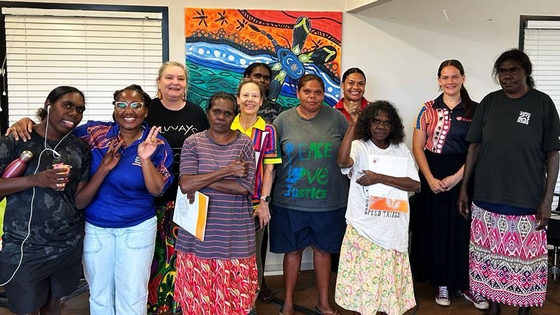
A short history of rheumatic heart disease in Australia
Blog: 20 October, 2023
Have you heard of rheumatic heart disease (RHD)?
No? You’re not alone...
That is probably because RHD has been almost eradicated in Australia. Despite that, RHD continues to disproportionately affect Aboriginal and Torres Strait Islander Peoples.
So why are the rates of Aboriginal and Torres Strait Islander Peoples suffering from RHD so high? First, let's find out what RHD is and how people get it.
What is RHD?
It starts with a group A streptococcus infection, or Strep A – a bacteria that can infect your throat or your skin. Strep A infections happen in millions of people worldwide per year. They are usually easily treated with antibiotics from a doctor and cause no ongoing health problems.
However, in some cases your body gets confused. While trying to fight the Strep A infection, it also starts to target your own cells (known as an autoimmune response). This leads to undesirable inflammation in the body – acute rheumatic fever.
This inflammation can occur in and around the heart – often affecting the four valves that control blood flow in to and out of the heart.
These heart valves can be left scarred after rheumatic fever, meaning they cannot open or close as they should which causes interruptions to blood flow around the body – this is rheumatic heart disease. This damage is permanent and there is no cure.
RHD in Australia
RHD used to be common in Australia. In the 1940s and 50s in Australia, the most common reason a bed was occupied in a children’s hospital was RHD.
The discovery of penicillin (to treat the Strep A infection), along with improved access to healthcare and improved socioeconomic conditions led to the rates of the disease declining dramatically.
Despite the overall reduction in rate of RHD in Australia, Aboriginal and Torres Strait Islander communities are disproportionately experiencing the disease. Māori and Pacific Islander peoples living in Australia are also at a higher risk.
The numbers of people affected are hard to gather, and they vary.
Some reports say that the rate of RHD is 61 times higher in Aboriginal and Torres Strait Islander Peoples. The Australian Institute of Health and Welfare found in 2019 that Aboriginal and Torres Strait Islander Peoples comprise over 80% of Australians living with RHD, and over 70% of RHD-related deaths. The risk of death from RHD in Aboriginal and Torres Strait Islander communities is 20 times that of Australians in the general population. In the Northern Territory, this jumps to over 50 times.
Whichever statistic you read; they are all alarming.
Why is there such a huge disparity in RHD in Australia?
RHD levels are closely linked with the socioeconomic status of a community.
A majority of Aboriginal and Torres Strait Islander Peoples experience social disadvantage including household overcrowding, and barriers to accessing to health care. These reasons lead to these communities experiencing RHD at a disproportionate rate.
RHD is preventable, but this relies upon reliable access to quality health care. Long term antibiotics can prevent the disease progressing by preventing reinfection with the Strep A bacteria. Regular monitoring with echocardiography can detect any changes in the heart early.
Barriers to health care for Aboriginal and Torres Strait Islander Peoples
Living in remote areas means that access to healthcare can be difficult – cost and availability of travel, and the need to spend sometimes extended periods away from home are all barriers.
It is also vital that healthcare services are culturally safe and responsive to the individual needs of patients. A doctor's visit can be daunting enough as it is. If someone doesn’t feel comfortable, understood or welcome, the appointment may simply become too much.
How does the future look?
Research in to RHD in Australia is aiming to address the disparity. The focus of some ongoing Heart Foundation funded research grants are:
A Strep A vaccine which may be able to prevent the RHD-causing Strep A infections.
Newly adapted imaging technique which may be able to prevent rheumatic fever from progressing to RHD.
Improving the way we count and track cases, so that no one falls through the gaps.
Addressing the emotional and social needs of people affected by RHD.
We are also helping to fund a number of projects including:
Access to health care is improving, as is early detection, treatment and management. However, there is still a way to go to close the gap – with many people still not accessing the healthcare they need.
If you would like to learn more about RHD in Australia:
Watch some videos on TakeHeartTV.
Visit the Take Heart, Deadly Heart website.
Read about the Deadly Heart Treks.
You might also be interested in...

Acute rheumatic fever (ARF) and rheumatic heart disease (RHD)
Rheumatic heart disease is a serious disease that causes damage to your heart valves.

What is acute rheumatic fever and rheumatic heart disease?
Rheumatic heart disease is a serious disease that causes damage to your heart valves.

Champions4Change
A national program that brings together people with the lived experience of acute rheumatic fever (ARF) and RHD.
Last updated18 November 2024